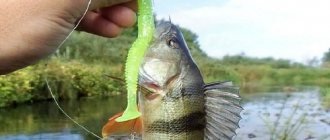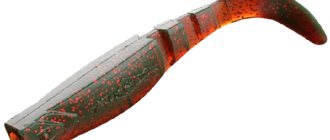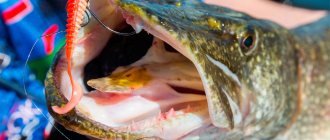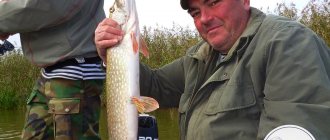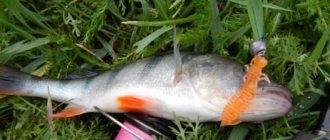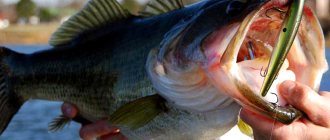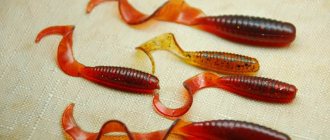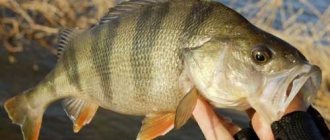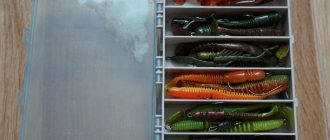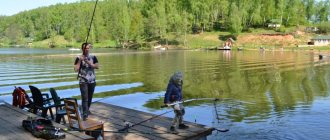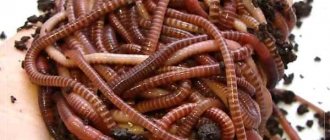The development of baits in fishing continues as usual. The variety of materials that abound in our world has brought changes to this area of human existence. In addition to classic artificial baits, fishing accessories made of silicone have come to the rescue.
Silicone in fishing is rapidly expanding the boundaries of its use. It is used to produce various types of bait for different types of fish. This is such a versatile material that it can be used in many different types of fishing. Spinning rod, float and feeder are just a partial list.
Requirements for lures for trout fishing
Silicone and trout fishing have also received attention. Proper use of silicone baits when catching this predator allows, if not completely replacing the classic bait options, then significantly expanding them.
When going trout fishing, every fisherman must have with him a small set of silicone baits, which allow more flexible control of the fishing process.
What will be included in it is determined by everyone independently, but the composition of the “trout” set must meet certain rules developed by more than one generation of fishermen.
- The size and weight of the bait is a key parameter when fishing for trout. As a rule, small sizes and weights are used. This is due to the anatomy of the trout mouth. Depending on the size of the fish being caught, baits from 6 to 60 cm long and weighing from 4 to 10 g are used.
- Bait behavior. If fishing takes place in places with fast currents, then the play of the silicone bait should be balanced. The main requirement for bait with an active fishing technique is its stable passage in the fast flow of the river, as well as during aggressive play with jerks.
- For standing reservoirs, the requirements for nozzles are somewhat different. What is needed here is a stable game at the same depth at a low retrieve speed, which is not so easy to achieve without a high-quality bait accessory.
- The next nuance is the color. The bait material used should imitate the natural food supply of trout in a particular body of water and river (stream). There are a large number of colors. The most popular colors are green, red and pink. The use of “acid” colors depends on the time of year of fishing. They are more suitable for fishing in muddy water.
- And the last thing that you should pay a lot of attention to is the hooks used in the equipment of silicone baits. The sharpening must be perfect, and it is better to use double or triple hooks.
Let's celebrate! It is better to prepare and determine which products to use in advance, before arriving for fishing. And on the spot it is already more precise, taking into account the fishing location and the time of year, to select this or that gear.
Where to start fishing at different times of the year
Fish activity depends on the season. Trout are considered cold-loving, so the peak bite occurs in the winter and spring months. Once on a pond in the spring, you need to choose active models of wobblers from your ammunition load. The color depends on the weather, water transparency and the mood of the fish. The administration of paid ponds tries to monitor the cleanliness of the reservoir, so in the cold season you can start with dark colors. However, the predator itself does not always favor natural colors. Having studied the set of wobblers for trout fishing by an experienced fisherman, you can understand that most of them are made in bright, provocative shades.
To learn more:
Using a non-hooking frog: what fish is it effective on?
As the weather gets warmer, the fish become lethargic and don’t bite as often. In summer, the results show trout baits for twitching. The wiring is performed with noticeable pauses. Fish walking in the upper layers can be seen with the help of polarized glasses. This gives an advantage over other fishermen, especially if the spinner has an accurate cast.
In winter, the predator is caught from the ice using sinking baits, for example, rattlins. Color and size depend on the specific body of water, so don’t shy away from experimenting.
Silicone lures for trout
There are a lot of baits offered by various manufacturers, and therefore you need to navigate this enormous variety well. These fishing consumables may differ in both shape and size, and color.
If everything is relatively clear in terms of the size and color of silicone trout baits, then with the shapes, especially for beginner spinning anglers, not everything is so clear. There is a wide range of this product, with names that you won’t immediately remember.
Vibrotails
This is a small artificial fish made of rubber (silicone), soft plastic or polymer. The vibrotail consists of a small body and tail.
Sometimes this bait looks like a long worm. The structure of the bait can be smooth or scaly-ribbed. It can completely replicate the structure of a small fish, which is not necessary.
The main role of this fishing structure is its tail section. Closer to the main body it is narrower, and the end is thicker and, as a rule, made at an angle. The tail can end in different ways: with a shovel, a notch, a spear, etc.
Advantages of silicone vibrotails:
- Similarity to live bait (live bait).
- Silicone is tolerant of low temperatures and does not lose its elasticity.
- Rubber vibrating tails can be made from edible silicone.
- Small price.
The only downside is that silicone wears out quickly (new ones need to be equipped frequently) and is inherently a consumable material.
Twisters
The curly ponytail was invented in the first half of the 70s by an American company. Russian fishermen called this bait a twister - a curl. Its body structure is similar to a worm with a flat, spiral tail. It can be equipped with other elements: a floating head, a firefly.
Like the vibrotail, the twister is an active bait designed for dynamic spinning fishing. However, it behaves well even with slow, imposing wiring.
Differences from vibrotail and advantages:
- The oscillation frequency of a twister is significantly higher than its counterpart, this is especially noticeable with a slow wiring method.
- The casting range allows fishing from the shore.
- It is not afraid of snags and is excellent for fishing in snags and places rich in vegetation.
- Its wiring behavior imitates cephalopods and crustacean mammals.
- Can be used as an addition to the main spinning bait.
Tubes
A very interesting and unique attachment. It takes its name from the word “tube”, translated into Russian as a tube. The design is simple: a hollow silicone cylinder equipped with tentacles.
It is equipped with a special hook, although there are practically none on sale on the Russian market, but it can be replaced with an offset hook and a pellet, which is placed inside the body from the side of the tentacles. Tubes are classified as light-weight gear - the weight of even the largest tube is 1-1.5 grams.
The tube is intended for fishing in the most snaggy, “evil” places with a lot of vegetation. This bait is thrown into the “windows”, time is given for it to sink on a slightly lowered fishing line and the game is played with a small jerk.
At the same time, the tube makes uneven, multi-vector movements, provoking the fish to attack. Even in case of the first failure, the bait can be released again and provocations can continue.
Note! This equipment, unusual for a Russian, behaves excellently on snags in forest rivers and reservoirs. It is practically not hooked, and in case of a snag it is not so valuable as to be upset.
Silicone worms
Another type of rubber fishing consumables is artificial worms. In their structural structure they are very similar to twisters. The main difference is the longer body.
The body of worms can be smooth or ribbed. The tails are cone-shaped and flat. The length of the body and tail are almost the same, although this is not necessarily the case. In general, silicone worms can vary in shape and size.
Worms are often made from edible rubber, and if not, the silicone is impregnated with various flavoring additives.
Pros of artificial worms:
- They are stored for a long time.
- Stays well on the hook.
- Impregnated with flavoring additives.
- Completely imitate natural bait.
Advantages of wobblers over other baits
Hovering is a characteristic feature of a wobbler with neutral buoyancy. Not a single species can float in the water column, provoking a predator to attack. It is this type of wobblers that is recommended for use in conditions of sluggish biting. When jerking, the spinner leaves the suspender alone for a while, waiting for a pause. Typically, 95% of attacks occur at this point.
Advantages of wobblers for trout fishing:
- variability of models (type, color, shape, size, weight, depth);
- high realization even when using barbless hooks;
- a small percentage of misses (except for surface baits);
- imitation of live fish.
Spinner baits are good in certain conditions, but are inferior to wobblers. Microjig silicone baits for trout are used if the predator is near the bottom. An effective pause allows the edible rubber to lie motionless on the bottom. Floating models (with a high salt content) are at this moment in a vertical position, which causes an appetite in the predator.
Top silicone baits
- In 5th place. Floating silicone from . Worms from this manufacturer showed very good results.
- In 4th place. Silicone nozzle for trout fishing from Ojas Oks. Floating larvae have proven excellent. Flies well, swims well.
- 3rd place. Silicone model Ribber Pupa from the manufacturer Trout Zone. Heavy silicone, perfect for both passive fishing for capricious trout and active play (excellent tail play).
- 2nd place. The well-known Larva silicone from LBaits. Corn and white colored baits are excellent for catching.
- Silicone leader for trout fishing. Large and small Plant baits from Trout Zone. The most catchable type of silicone.
Reviews from fishermen
My opinion is this... Everything is important: color, shape, edibility and presentation. There are edible baits that are caught almost always, and there are ones that catch at certain times. When the fish is hungry and actively biting, it doesn’t matter what kind of bait... Chinese oak or soft branded bait. For myself, I have personally identified several types and colors that I am confident in. By company, these are luckyjohn and Rybalov. Grade:
Andrey
Recently I experimented with a new product from a Japanese rubber manufacturer. Jackall Wobbring measures 3 inches. The bait, something between a twister and a vibrotail, was mounted with a classic jig - no problems, the rubber did not tear, I led it with offset. The first throw is an attack. On a classic jig - a stable bite. And what pleased me was that the rubber was practically undamaged. Grade:
Kirill
Excellent Larva silicone equipment from Fanatik. The lure is 1.6 inches long, similar in structure to a dragonfly larva, with lurex, edible rubber. I use it for ultralight jig tackle. He behaves great. The packaging says it's predatory, but everyone takes it. In terms of catchability - five points. So I recommend it! Grade:
Vadim
We have been using it for several years now. Low price, many color options. Larva is very catchy, we practice active fishing. We mainly choose dragonfly and leech, the colors are brown and purple. If you get hooked, you don’t mind losing – the price is symbolic. I recommend it to all beginners! Grade:
Alexander
Jackall I Shad Tail 3.8′ – Japanese tires. Moderate stiffness. She lived for a long time - she withstood ten bites. The shape is unique, I've never seen anything like it before. I equipped it only with offset, I don’t recognize doubles. You need to try this form only in a smaller size - I’m sure there will be more bites. And yet it is the fisherman who catches the fish, not the bait! Grade:
Valery
In conclusion of the article, it should be noted that silicone baits should be stored in special polymer packaging, preventing air from entering. Then you will be sure that the bait will retain its elasticity and attractive smell.
